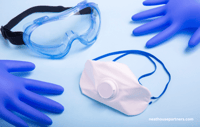Advances In PPE & The Responsibilities Of An Employer To Consider
Advances In PPE & The Responsibilities Of An Employer To Consider
James Rowland
Commercial Director James leads Account Management, Sales and Marketing at Neathouse Partners.Date
06 June 2023Updated
20 March 2024
Table of contents
Related articles
Tags
Personal Protective Equipment (PPE) is constantly evolving to provide improved safety to those who wear it.
As an employer, you must meet your obligations surrounding the provision and maintenance of Personal Protective Equipment (PPE) for your workers as outlined in various regulations under the Health and Safety at Work Act 1974.
To do this, it's important that you stay on top of advances in PPE such as;
- Enhanced PPE Design: Improvements in ergonomics and comfort, leading to better fit and usability for extended periods.
- Modular PPE: Interchangeable components allow greater flexibility and adaptability in different work environments.
- Nanofiber Materials: The use of nanofibers in PPE offers superior protection against pathogens while being lightweight and breathable.
- Reusable PPE: Innovations in durable materials enable the reuse of certain types of PPE, reducing waste and easing supply chain burdens.
- Recycled Materials: Some PPE are now made from recycled materials, making production more sustainable and cost-effective.
- Smart PPE: Integration of sensors and other technologies for automatic disinfection, real-time monitoring, and data analysis.
- Augmented Reality (AR): Use of AR technology to provide real-time information and guidance to workers, helping to improve safety, reduce training time, and streamline processes.
Your Employer Responsibilities Surrounding PPE
The following legislation set out your responsibility as an employer when it comes to supplying appropriate and effective PPE that ensures the health and safety of workers, including remote workers, in the workplace.
- The Personal Protective Equipment at Work Regulations 1992 make it mandatory for employers to supply appropriate PPE to employees who may be exposed to a risk to their health or safety while at work, except where such risk has been adequately controlled by other means.
- Employers are also obligated to assess the suitability of PPE considering the type and level of risk, the fit for the individual wearer, and the conditions of its use. You must also ensure that your staff are given appropriate training on how to use and care for the PPE correctly, and to replace worn-out or damaged PPE promptly.
- The Management of Health and Safety at Work Regulations 1999 further underscores the requirement for employers to carry out risk assessments. Employers should identify hazards in the workplace, evaluate the risk of these hazards causing harm, and decide on suitable measures to eliminate or control these risks. The results of this assessment can inform the type of PPE required.
- Finally, the Equality Act 2010 means employers should ensure that PPE is suitable for all workers, regardless of gender, size, disability, or religious dress requirements.
| Legislation | Employer's Responsibilities |
|---|---|
| Health and Safety at Work Act 1974 | Enshrines the employer's duty to ensure the health and safety of their employees in the workplace. |
| Personal Protective Equipment at Work Regulations 1992 | Mandates employers to provide suitable PPE to employees exposed to any risk to their health or safety at work, except where such risk has been sufficiently controlled by other means. Employers are obligated to assess the PPE's appropriateness, considering the type and level of risk, the individual wearer's fit, and the conditions of its use. Employers must provide adequate training to employees on how to use and care for the PPE correctly and ensure timely replacement of worn-out or damaged PPE. |
| Management of Health and Safety at Work Regulations 1999 | Reinforces the requirement for employers to conduct risk assessments. Employers should identify hazards, evaluate their risk of causing harm, and decide on suitable measures to eliminate or control these risks. The results of this assessment inform the type of PPE required. |
| Equality Act 2010 | Employers must ensure PPE is suitable for all workers, irrespective of gender, size, disability, or religious dress requirements. |
Advances In Personal Protective Equipment
As PPE is often worn for prolonged periods, particularly by healthcare professionals, comfort has become an integral aspect of PPE design.
Advances in design including the use of lighter and more flexible materials have reduced the weight and improved wearability, ensuring better comfort and ease of movement for the user.
Modularity in PPE Design
An impressive advancement in PPE is the concept of modularity.
Modular PPE, featuring interchangeable components like masks or shields, grants greater flexibility and adaptability, tailoring to different working conditions and boosting safety standards.
Innovations in PPE Material
The effectiveness of PPE hinges significantly on the materials used.
Recent advancements in material sciences have led to an improvement in the protective capacity of PPE.
Nanofiber Applications
One exciting innovation is the use of nanofibers in PPE. Exceptionally effective in blocking the transmission of pathogens and hazardous materials, nanofibers have found application in the manufacturing of masks, gowns, and more. This allows for lighter, more breathable equipment, promoting comfort during extended wear.
Reusable and Recycled Materials
The trend towards reusable PPE, thanks to durable materials, not only reduces waste but also alleviates pressure on supply chains, offering a more cost-effective and environmentally-friendly solution.
In a step towards sustainability, some manufacturers have incorporated recycled materials in PPE production, further reducing waste and making PPE more affordable.
Technological Advancements in PPE
Smart PPE
A revolutionary development is the inception of smart PPE, equipped with sensors and other tech features that enable automatic disinfection, real-time monitoring, and data analysis.
Such capabilities help reduce cross-contamination risks, promote proactive safety measures, and enhance overall user comfort.
Augmented Reality in PPE
Augmented Reality (AR), once popularised by games like Pokemon Go, is now lending its capabilities to PPE technology too.
AR can provide real-time information and guidance to users, illustrating correct usage and highlighting potential hazards. Such applications can reduce training time, bolster safety measures, and streamline processes, reducing the need for manual intervention.
These strides in PPE design and technology are continuously shaping the future of safety, whilst delivering improved functionality and user comfort.
Your role as an employer means you should stay abreast of these developments and make sure to integrate them effectively into your workplace safety protocols where relevant.
Implications of Neglecting PPE Obligations as an Employer
The global COVID-19 pandemic has significantly redefined PPE guidelines and placed additional emphasis on employers providing appropriate PPE for specific roles to mitigate the virus's transmission in the workplace.
Non-compliance with PPE obligations could have serious legal repercussions, including hefty fines and even prosecution.
On top of that, non-compliance can also adversely affect an organisation's reputation, and its relationships with employees, which can ultimately reduce productivity due to increased health risks and potential for work disruptions.
Further reading: Managing H&S in a pandemic - lessons learned and best practice to follow
Summary
Staying up-to-date with the latest advancements in PPE technology is not just a matter of best practice, but also a legal necessity.
Taking pro-active steps to understand the advancements outlined above, communicate them with your team, and implementing them where relevant in your business, are essential for creating a safer work environment that shows a commitment to the well-being of your employees.
Contact us at 01244 893776 for tailored advice designed to help you to meet your employer's responsibilities surrounding the use of PPE.
Related blog posts

Safeguarding Your Workplace: A Comprehensive Guide to Manual Handling

How do you safeguard in health and social care? Guidance for employers

Employees' rights at work during cold weather

Creating a sun safe workplace
Have questions?
Get in touch today
Contact us, and our team will get back to you within 24 hours. We value your questions and are committed to getting them answered quickly.


Hello! I am Nicky
Just fill in the form below with your details, and I will arrange for a member of our team to give you a call.
By clicking, you agree to our Privacy Policy






